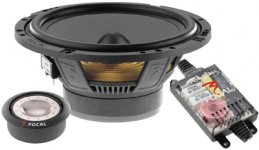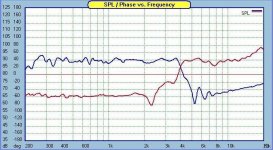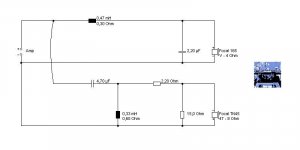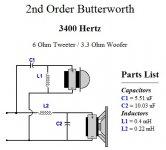Hi , my name is Panagiotis and I would like to ask some questions
I have 2 pairs of Focal 165 V but I forgot the crossovers on my old car and I cannot find them now , so I decide to make a crossover to use them to my new one
I want to ask the following questions
1) when I connect the Tweeter and the crossover the impedance change as it will with 2 same loudspeakers or not ?
2) If I do not cross the woofer will I destroy it or just his sound ?
3) The coil wire diameter have to do with the watt of the loundspeaker or is just the wider the better ?
4) I use some of the calculators and decide to use the folowing componets
10 uf CLARITYCAP - Polypropylene SA type first I thing to choose 12 uf but this going at 3300 hz when focal cross it to 3500 and I am afraid that this + that now I am cuting off with 6 db/ octave and not 12 I will burn them so I decide to go safe cross them about at 4000 hz
An MUNDORF TYPE - BA140 - M-Coil rod-core coils, wire Ø 1.40mm (baked varnished)
at 0,15 Mh
will they do the job ?
Also I read about the zobel filter but I do not understood if I need one for woofer and one for the tweeter and how I connect them .
Thanks in advance and sorry of asking to much on a since post
I have 2 pairs of Focal 165 V but I forgot the crossovers on my old car and I cannot find them now , so I decide to make a crossover to use them to my new one
I want to ask the following questions
1) when I connect the Tweeter and the crossover the impedance change as it will with 2 same loudspeakers or not ?
2) If I do not cross the woofer will I destroy it or just his sound ?
3) The coil wire diameter have to do with the watt of the loundspeaker or is just the wider the better ?
4) I use some of the calculators and decide to use the folowing componets
10 uf CLARITYCAP - Polypropylene SA type first I thing to choose 12 uf but this going at 3300 hz when focal cross it to 3500 and I am afraid that this + that now I am cuting off with 6 db/ octave and not 12 I will burn them so I decide to go safe cross them about at 4000 hz
An MUNDORF TYPE - BA140 - M-Coil rod-core coils, wire Ø 1.40mm (baked varnished)
at 0,15 Mh
will they do the job ?
Also I read about the zobel filter but I do not understood if I need one for woofer and one for the tweeter and how I connect them .
Thanks in advance and sorry of asking to much on a since post
The main thing to do is protect the tweeter. I would try and make sure that the cross-over was 12db per octave and NOT just 6. You should try and have a coil across the tweeter to make it a 12 db per octave slope.
If you put an inductor (coil) in the woofer (bass) speaker the impedence will remain the same. The speakers are probably both 4 ohm.
If you do not cross over the bass speaker you wont destroy the speaker but the sound won't be as good. But the impedence of the system may get too low and that could cause problems for the amplifier...
The Zobel network is not very important.
Good luck,,,,,Jonathan
If you put an inductor (coil) in the woofer (bass) speaker the impedence will remain the same. The speakers are probably both 4 ohm.
If you do not cross over the bass speaker you wont destroy the speaker but the sound won't be as good. But the impedence of the system may get too low and that could cause problems for the amplifier...
The Zobel network is not very important.
Good luck,,,,,Jonathan
i just found more data
http://www.focal-fr.com/catalogue-docs/EN/15/files/1245.pdf
http://www.focal-fr.com/catalogue-docs/EN/15/files/1302.pdf
not sure about the tweeter since mine has another color maybe cause it is 5 years old maybe they change it
http://www.focal-fr.com/catalogue-docs/EN/15/files/1245.pdf
http://www.focal-fr.com/catalogue-docs/EN/15/files/1302.pdf
not sure about the tweeter since mine has another color maybe cause it is 5 years old maybe they change it
Attachments
Last edited:
I understand you checked is the TN45 tweeter. Some 165 Kits also had the Focal TN47 tweeter. They seem (TN45) to be x-ing at ~4K anyway.
Attachments
Is it possible to write tn45 on it and be a tn 47 ?
So on my question
how i cross it ? and how i make it 4 ohm since my tweter is 8 ohm ? i thing zobel is the solution but how i make it etc etc
do a good parts 6 db/oct + zobel going to be better than an 12 db/oct with cheaper componets ? even more do a good 6 db/oct will sound better than the one that the speakers come with ?
Thanks
So on my question
how i cross it ? and how i make it 4 ohm since my tweter is 8 ohm ? i thing zobel is the solution but how i make it etc etc
do a good parts 6 db/oct + zobel going to be better than an 12 db/oct with cheaper componets ? even more do a good 6 db/oct will sound better than the one that the speakers come with ?
Thanks
the usual '4' or '8' ohm ratings are called 'nominal' impedance - just an approximate guide to the impedance of the driver. I reality, impedance varies with frequency. If you look at the data sheet graph, the lower trace is a graph of the impedance of the driver varying with frequency. Read off the impedance value at your chosen crossover frequency, and use that in your calculations.
re:'do a good parts 6 db/oct + zobel going to be better than an 12 db/oct with cheaper componets ?' - unlikely, stick with 12dB/oct for best protection of the tweeter
re:'do a good parts 6 db/oct + zobel going to be better than an 12 db/oct with cheaper componets ?' - unlikely, stick with 12dB/oct for best protection of the tweeter
A cone/dome speakers impedance is basically the voice coil's DC resistance (DCR) at low frequencies. Then, it climbs to a peak at resonance, dips back down to a valley which could be nearly as low as the DCR, then slowly climbs with increasing frequency.
The climb is NOT caused by voice coil "inductance"; it is caused by eddy currents in the magnet structure. So, the rise is kind of the square root of an inductance.
Zobel networks try to flatten the impedance.
- A high frequency Zobel is usually a series RC combo in parallel with the speaker. The resistor would usually be roughly equal to DCR. At higher and higher frequencies, the RC impedance decreases while the speaker impedance increases. In theory, this would make a perfectly flat impedance at high frequencies. It may not be flat due to the resonance peak, and because the speaker impedance is not increasing inductively-but it can still work well.
- A resonance Zobel would usually be parallel R, L, C all in parallel with the speaker, if memory serves. The resistor is roughly the value which in parallel with the resonance peak impedance would yield DCR. Basically, the network makes a kind of impedance dip at the point where the speaker impedance peaks.
With so many variables, you can see why you need real measurements on the actual individual drivers (not even data sheets, maybe). If you don't have it, then you have to guess, and allow for more experimentation (i.e. order extra parts and play around).
Several observations come to mind:
- A coil on a woofer will do almost nothing due to the speaker's impedance rise. A zobel can fix that, but not perfectly.
- 6 dB on a tweeter is very very crude and only recommended for the cheapest car coaxials, not for anything serious. (OK, unless you are building a very sophisticated system with impedance compensation and actual individual frequency response and phase data).
- 12 dB is much better. However, unless your crossover frequency is >2x the resonance, there will be a bump where the tweeter output comes up again below the crossover frequency.
- You cannot base crossovers on "4 ohm" "8 ohm" except very crudely, just as a gross starting point. Real transducers are far from resistors.
- Do not think you can calculate how much the crossover reduces the frequency responses, then add woofer + tweeter. Actual phase can vary a lot, and certainly at the upper range of a woofer it may not be well behaved.
A lot of generalities, I know. Unfortunately I don't have a simulator here to suggest some starting values for experimentation-I hope someone else does and will be generous to help you.
The climb is NOT caused by voice coil "inductance"; it is caused by eddy currents in the magnet structure. So, the rise is kind of the square root of an inductance.
Zobel networks try to flatten the impedance.
- A high frequency Zobel is usually a series RC combo in parallel with the speaker. The resistor would usually be roughly equal to DCR. At higher and higher frequencies, the RC impedance decreases while the speaker impedance increases. In theory, this would make a perfectly flat impedance at high frequencies. It may not be flat due to the resonance peak, and because the speaker impedance is not increasing inductively-but it can still work well.
- A resonance Zobel would usually be parallel R, L, C all in parallel with the speaker, if memory serves. The resistor is roughly the value which in parallel with the resonance peak impedance would yield DCR. Basically, the network makes a kind of impedance dip at the point where the speaker impedance peaks.
With so many variables, you can see why you need real measurements on the actual individual drivers (not even data sheets, maybe). If you don't have it, then you have to guess, and allow for more experimentation (i.e. order extra parts and play around).
Several observations come to mind:
- A coil on a woofer will do almost nothing due to the speaker's impedance rise. A zobel can fix that, but not perfectly.
- 6 dB on a tweeter is very very crude and only recommended for the cheapest car coaxials, not for anything serious. (OK, unless you are building a very sophisticated system with impedance compensation and actual individual frequency response and phase data).
- 12 dB is much better. However, unless your crossover frequency is >2x the resonance, there will be a bump where the tweeter output comes up again below the crossover frequency.
- You cannot base crossovers on "4 ohm" "8 ohm" except very crudely, just as a gross starting point. Real transducers are far from resistors.
- Do not think you can calculate how much the crossover reduces the frequency responses, then add woofer + tweeter. Actual phase can vary a lot, and certainly at the upper range of a woofer it may not be well behaved.
A lot of generalities, I know. Unfortunately I don't have a simulator here to suggest some starting values for experimentation-I hope someone else does and will be generous to help you.
0) I have 2 pairs of Focal 165 V but I forgot the crossovers on my old car and I cannot find them now...
1) when I connect the Tweeter and the crossover the impedance change as it will with 2 same loudspeakers or not ?
2) If I do not cross the woofer will I destroy it or just his sound ?
3) The coil wire diameter have to do with the watt of the loundspeaker or is just the wider the better ?
0) Mmmm, why not ask Focal for a schematic?
1) Can you re-state the question? I don't understand.
2) No harm caused. Just a little more power coming in. No crossover on a tweeter will lead to destruction. 6 dB crossover may also lead to destruction.
3) Coil D.C. resistance is key. Bigger coil wire makes this lower, and the coil more ideal.
0) Mmmm, why not ask Focal for a schematic?
1) Can you re-state the question? I don't understand.
The nominal is 8 ohms for the tweeter and 4 ohms for the wofeer when i connect them parallel with a crossover will my amplifier see an 2.66 ohms loud speakers (like i think will) or something else that is frequency dependable ?
You can start with something like this (you can use 0.5i/2.5c on woofer)
The impedance doesn't go lower than 4 Ohm because of the crossover frequency/separation of drivers working band.
To adjust attenuation of the tweeter use a calculator here
The impedance doesn't go lower than 4 Ohm because of the crossover frequency/separation of drivers working band.
To adjust attenuation of the tweeter use a calculator here
Attachments
Last edited:
The impedance doesn't go lower than 4 Ohm...
4 Ohm (min.)Thanks i will give it a trywith this i will have 4 ohm or 2.6 ohms final imendance to choose the amplifier i will use .
Attenuation for tweeter, with R1/R2, is set for ~3dB, flat response (with woofer L1~0,50mH) ~90dB. With bigger coil, say a 0,68mH L1/woofer (less mids) more attenuation is needed.
FA165V2 crossover for 165V2 (each) $68, 2009 (Australia)
EBAY http://cgi.ebay.de/Focal-Polyglass-165-v2-16cm-Komponenten-System-2-Wege-/290413719726
Last edited:
Thanks i will give it a try...
A lot of people don't even say it. They just take it and leave... and (they/diyAudio-posters) don't even report back.
Last edited:
The nominal is 8 ohms for the tweeter and 4 ohms for the wofeer when i connect them parallel with a crossover will my amplifier see an 2.66 ohms loud speakers (like i think will) or something else that is frequency dependable ?
Ah, I see you are misunderstanding a bit. Focus on the word "NOMINAL": the nominal impedance is really more like a minimum impedance. An 8 ohm speakers impedance will vary from maybe 6 ohms at DC, rising to 10-100+ ohms at the resonance frequency (depending on the construction), then decreasing to around 8 ohms, then rising up and up at higher frequencies in a semi-inductive way due to eddy current in the magnet (not actually due to the tiny inductance of the voice coil). So the "8 ohms" is just a kind of rough midrange value.
The crossover for the tweeter has an impedance that gets larger and larger at low frequencies, absorbing the voltage from the amp and blocking it from the tweeter. Likewise, the woofer crossover impedance rises at high frequencies and blocks them.
So if you had an 8 ohm woofer and 4 ohm tweeter, you won't get 2.6. You'll get the woofer's resonance peak impedance, then falling towards 8 ohms, then falling more towards the tweeter's 4 ohm impedance at high frequencies.
Since there is little power at high frequencies, that should be fine for most any amplifiers.
I use this calculator ZOBEL Filters for CROSSOVER Networks
and i have 2 zobels (1 for tweeter 1 for woofer ) using the data sheet from focal . Do this change the design ? it is also from a calculator
also is my idea or the woofer already have a zobel network on your design ?
i also want to the picture design + 2 zobels but afraid i am going to damage my focals you know trying for the best
you know trying for the best 
and i have 2 zobels (1 for tweeter 1 for woofer ) using the data sheet from focal . Do this change the design ? it is also from a calculator
also is my idea or the woofer already have a zobel network on your design ?
i also want to the picture design + 2 zobels but afraid i am going to damage my focals
Attachments
Last edited:
- Status
- This old topic is closed. If you want to reopen this topic, contact a moderator using the "Report Post" button.
- Home
- Loudspeakers
- Multi-Way
- Crossover questions



